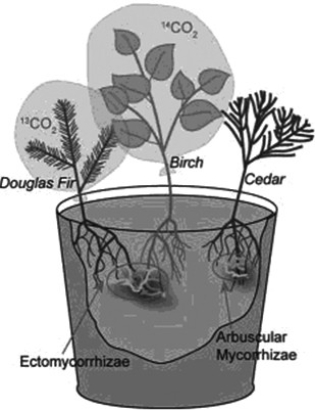Suzanne Simard and colleagues knew that the same mycorrhizal fungal species could colonise multiple types of trees. They wondered if the same fungal individual would colonise different trees, forming an underground network that potentially could transport carbon and nutrients from one tree to another (S. Simard et al. 1997. Net transfer of carbon between mycorrhizal tree species in the field. Nature 388:579-82) .
Pots containing seedlings of three different tree species were set up and grown under natural conditions for three years (Fig.A) . Two of the three species (Douglas fir, birch) could form ectomycorrhizal connections with the same fungal species, but the third species (cedar) could not form an ectomycorrhizal connection with the fungal species. In some of the pots, the researchers placed airtight bags over the Douglas fir and birch seedlings and injected carbon dioxide made from carbon-13 into the bags with the Douglas fir and carbon dioxide made from carbon-14 into the bags with the birch. (13C and 14C are different isotopes of carbon that can be detected and measured by researchers.) As the seedlings photosynthesised, the carbon dioxide was converted into sugars that could be tracked and measured by the researchers. The researchers measured whether the sugars in each plant contained only the carbon isotope that was in the air of their plastic bag or also the carbon isotope from the air around the other plant.
Figure A
-Based on the idea that fungi have pores between their cell walls that allow cytoplasm to move from one end of the mycelium to the other, which of the following hypotheses is the most plausible?
Definitions:
Q2: Loss of water from the aerial parts
Q13: If the mitosomes of Giardia contain no
Q19: Which of the following soil minerals is
Q35: In addition to seeds, which of the
Q43: Fungi interact with many organisms in mutualistic
Q43: The fact that amoebas are not monophyletic
Q47: Aphids are Hemiptera that suck phloem liquid
Q49: In a bacterium that possesses antibiotic resistance
Q54: Which of the following sex and generation
Q74: Which one of the following statements about